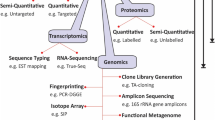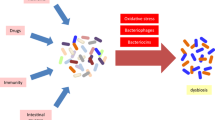Abstract
Massive blood loss, a common pathological complication in the clinic, is often accompanied by altered gut integrity and intestinal wall damage. Little is known to what extent the gut microbiome could be correlated with this process. The gut microbiome plays a crucial role in human health, especially in immune and inflammatory responses. This study aims to determine whether acute blood loss affects the gut microbiome and the dynamic variation of the gut microbiome following the loss of blood. We used New Zealand rabbits to mimic the blood loss complication and designed a five-time-point fecal sampling strategy including 24-h pre-blood loss procedure, 24 h, 36 h, 48 h, and 1-week post-blood loss procedure. Gut microbiome composition and diversity were analyzed using 16S rRNA gene sequencing and downstream α-diversity, β-diversity, and taxonomy analysis. The gut microbiome changed dramatically after blood loss procedure. There was a significant increase in diversity and richness of the gut microbiome at 24-h post-procedure (P = 0.038). Based on an analysis of similarities, the composition of gut microbiome in the samples collected at 24-h post-procedure was significantly different from that of pre-procedure samples (r = 0.79, P = 0.004 weighted unifrac distance; r = 0.99, P = 0.002, unweighted unifrac distance). The relative abundance of Lactobacillus was significantly decreased in the post-procedure samples (P = 0.0006), while the relative abundance of Clostridiales (P = 0.018) and Bacteroidales (P = 0.015) was significantly increased after procedure. We also found the relative abundance of Bacilli, Lactobacillus, Myroides, and Prevotella decreased gradually at different time points after blood loss. The relative abundance of the Clostridia, Alphaproteobacteria, and Sporosarcina increased at 24-h post-procedure and decreased thereafter. This preliminary study discovered potential connections between blood loss and dysbiosis of gut microbiome. The diversity and abundance of the gut microbiome was affected to various extents after acute blood loss and unable to be restored to the original microbiome profile even after one week. The increase in relative abundance of opportunistic pathogens after blood loss could be an important indication to reconsider immune and inflammatory responses after acute blood loss from the perspective of gut microbiome.







Similar content being viewed by others
References
Allaire JM, Crowley SM, Law HT, Chang SY, Ko HJ, Vallance BA (2018) The intestinal epithelium: central coordinator of mucosal immunity. Trends Immunol. https://doi.org/10.1016/j.it.2018.04.002
Zuo T, Kamm MA, Colombel JF, Ng SC (2018) Urbanization and the gut microbiota in health and inflammatory bowel disease. Nat Rev Gastroenterol Hepatol. https://doi.org/10.1038/s41575-018-0003-z
Singh N, Gurav A, Sivaprakasam S, Brady E, Padia R, Shi H, Thangaraju M, Prasad PD, Manicassamy S, Munn DH, Lee JR, Offermanns S, Ganapathy V (2014) Activation of Gpr109a, receptor for niacin and the commensal metabolite butyrate, suppresses colonic inflammation and carcinogenesis. Immunity 40(1):128–139. https://doi.org/10.1016/j.immuni.2013.12.007
Wang B, Yao M, Lv L, Ling Z, Li L (2017) The human microbiota in health and disease. Engineering 3(1):71–82. https://doi.org/10.1016/j.eng.2017.01.008
Mittal R, Coopersmith CM (2014) Redefining the gut as the motor of critical illness. Trends Mol Med 20(4):214–223. https://doi.org/10.1016/j.molmed.2013.08.004
Belenkiy SM, Berry JS, Batchinsky AI, Kendrick C, Necsoiu C, Jordan BS, Salinas J, Cancio LC (2014) The noninvasive carbon dioxide gradient (NICO2G) during hemorrhagic shock. Shock 42(1):38–43. https://doi.org/10.1097/SHK.0000000000000177
Cothren CC, Moore EE, Hedegaard HB, Meng K (2007) Epidemiology of urban trauma deaths: a comprehensive reassessment 10 years later. World J Surg 31(7):1507–1511. https://doi.org/10.1007/s00268-007-9087-2
Mira JC, Brakenridge SC, Moldawer LL, Moore FA (2017) Persistent inflammation, immunosuppression and catabolism syndrome. Crit Care Clin 33(2):245–258. https://doi.org/10.1016/j.ccc.2016.12.001
Stortz JA, Murphy TJ, Raymond SL, Mira JC, Ungaro R, Dirain ML, Nacionales DC, Loftus TJ, Wang Z, Ozrazgat-Baslanti T, Ghita GL, Brumback BA, Mohr AM, Bihorac A, Efron PA, Moldawer LL, Moore FA, Brakenridge SC (2018) Evidence for persistent immune suppression in patients who develop chronic critical illness after sepsis. Shock 49(3):249–258. https://doi.org/10.1097/SHK.0000000000000981
Xiao W, Mindrinos MN, Seok J, Cuschieri J, Cuenca AG, Gao H, Hayden DL, Hennessy L, Moore EE, Minei JP, Bankey PE, Johnson JL, Sperry J, Nathens AB, Billiar TR, West MA, Brownstein BH, Mason PH, Baker HV, Finnerty CC, Jeschke MG, Lopez MC, Klein MB, Gamelli RL, Gibran NS, Arnoldo B, Xu W, Zhang Y, Calvano SE, McDonald-Smith GP, Schoenfeld DA, Storey JD, Cobb JP, Warren HS, Moldawer LL, Herndon DN, Lowry SF, Maier RV, Davis RW, Tompkins RG (2011) A genomic storm in critically injured humans. J Exp Med 208(13):2581–2590. https://doi.org/10.1084/jem.20111354
Seal JB, Alverdy JC, Zaborina O, An G (2011) Agent-based dynamic knowledge representation of Pseudomonas aeruginosa virulence activation in the stressed gut: towards characterizing host-pathogen interactions in gut-derived sepsis. Theor Biol Med Model 8:33. https://doi.org/10.1186/1742-4682-8-33
Rupani B, Caputo FJ, Watkins AC, Vega D, Magnotti LJ, Lu Q, Xu DZ, Deitch EA (2007) Relationship between disruption of the unstirred mucus layer and intestinal restitution in loss of gut barrier function after trauma hemorrhagic shock. Surgery 141(4):481–489. https://doi.org/10.1016/j.surg.2006.10.008
Wang X, Zhang L, Wang Y, Liu X, Zhang H, Liu Y, Shen N, Yang J, Gai Z (2018) Gut microbiota dysbiosis is associated with Henoch-Schonlein Purpura in children. Int Immunopharmacol 58:1–8. https://doi.org/10.1016/j.intimp.2018.03.003
Magoc T, Salzberg SL (2011) FLASH: fast length adjustment of short reads to improve genome assemblies. Bioinformatics 27(21):2957–2963. https://doi.org/10.1093/bioinformatics/btr507
Caporaso JG, Kuczynski J, Stombaugh J, Bittinger K, Bushman FD, Costello EK, Fierer N, Pena AG, Goodrich JK, Gordon JI, Huttley GA, Kelley ST, Knights D, Koenig JE, Ley RE, Lozupone CA, McDonald D, Muegge BD, Pirrung M, Reeder J, Sevinsky JR, Turnbaugh PJ, Walters WA, Widmann J, Yatsunenko T, Zaneveld J, Knight R (2010) QIIME allows analysis of high-throughput community sequencing data. Nat Methods 7(5):335–336. https://doi.org/10.1038/nmeth.f.303
Edgar RC (2010) Search and clustering orders of magnitude faster than BLAST. Bioinformatics 26(19):2460
Cole JR, Wang Q, Cardenas E, Fish J, Chai B, Farris RJ, Kulam-Syed-Mohideen AS, McGarrell DM, Marsh T, Garrity GM, Tiedje JM (2009) The ribosomal database project: improved alignments and new tools for rRNA analysis. Nucleic Acids Res 37(3D):D141–145. https://doi.org/10.1093/nar/gkn879
Langille MG, Zaneveld J, Caporaso JG, McDonald D, Knights D, Reyes JA, Clemente JC, Burkepile DE, Vega Thurber RL, Knight R, Beiko RG, Huttenhower C (2013) Predictive functional profiling of microbial communities using 16S rRNA marker gene sequences. Nat Biotechnol 31(9):814–821. https://doi.org/10.1038/nbt.2676
Lord JM, Midwinter MJ, Chen YF, Belli A, Brohi K, Kovacs EJ, Koenderman L, Kubes P, Lilford RJ (2014) The systemic immune response to trauma: an overview of pathophysiology and treatment. Lancet 384(9952):1455–1465. https://doi.org/10.1016/S0140-6736(14)60687-5
Campbell C, Dikiy S, Bhattarai SK, Chinen T, Matheis F, Calafiore M, Hoyos B, Hanash A, Mucida D, Bucci V, Rudensky AY (2018) Extrathymically generated regulatory T cells establish a niche for intestinal border-dwelling bacteria and affect physiologic metabolite balance. Immunity. https://doi.org/10.1016/j.immuni.2018.04.013
Vilela SF, Barbosa JO, Rossoni RD, Santos JD, Prata MC, Anbinder AL, Jorge AO, Junqueira JC (2015) Lactobacillus acidophilus ATCC 4356 inhibits biofilm formation by C. albicans and attenuates the experimental candidiasis in Galleria mellonella. Virulence 6(1):29–39. https://doi.org/10.4161/21505594.2014.981486
Goncalves P, Araujo JR, Di Santo JP (2018) A cross-talk between microbiota-derived short-chain fatty acids and the host mucosal immune system regulates intestinal homeostasis and inflammatory bowel disease. Inflamm Bowel Dis 24(3):558–572. https://doi.org/10.1093/ibd/izx029
Furusawa Y, Obata Y, Fukuda S, Endo TA, Nakato G, Takahashi D, Nakanishi Y, Uetake C, Kato K, Kato T, Takahashi M, Fukuda NN, Murakami S, Miyauchi E, Hino S, Atarashi K, Onawa S, Fujimura Y, Lockett T, Clarke JM, Topping DL, Tomita M, Hori S, Ohara O, Morita T, Koseki H, Kikuchi J, Honda K, Hase K, Ohno H (2013) Commensal microbe-derived butyrate induces the differentiation of colonic regulatory T cells. Nature 504(7480):446–450. https://doi.org/10.1038/nature12721
Allali I, Boukhatem N, Bouguenouch L, Hardi H, Boudouaya HA, Cadenas MB, Ouldim K, Amzazi S, Azcarate-Peril MA, Ghazal H (2018) Gut microbiome of Moroccan colorectal cancer patients. Med Microbiol Immunol. https://doi.org/10.1007/s00430-018-0542-5
Seike S, Takehara M, Takagishi T, Miyamoto K, Kobayashi K (1860) Nagahama M (2018) Delta-toxin from Clostridium perfringens perturbs intestinal epithelial barrier function in Caco-2 cell monolayers. Biochim Biophys Acta 2:428–433. https://doi.org/10.1016/j.bbamem.2017.10.003
Kanneganti TD, Lamkanfi M, Nunez G (2007) Intracellular NOD-like receptors in host defense and disease. Immunity 27(4):549–559. https://doi.org/10.1016/j.immuni.2007.10.002
Sobrino J, Shafi S (2013) Timing and causes of death after injuries. Proceedings 26(2):120–123
Acknowledgements
This study was supported by the Shandong Provincial Key Research and Development Program under contract No. 2018CXGC1219 (to ZG) and No. 2016YYSP009 (to LZ), the National Natural Science Foundation of China under contract No. 31471202 (to LZ) and No. 81671362 (to YW); and the Weihai Technique Extension Project under contract No. 2016GNS023 (to LZ). Lei Zhang is also supported by the Taishan Scholars Program of Shandong Province (No. tshw20120206) and Taishan Industry Leading Talent Program of Shandong Province.
Author information
Authors and Affiliations
Contributions
LZ, JY, and XH designed the study; XM, YW, SH, ZGCZ, and ZZ performed measurements and data analysis; CZ and DZ obtained samples; JZ JY, and LZ wrote the manuscript; and JY and LZ revised the manuscript extensively. All authors have read and critically revised the manuscript.
Corresponding authors
Ethics declarations
Conflict of interest
I can confirm I have included a statement regarding data and material availability in the declaration section of my manuscript. All authors declare that there is no conflict of interests regarding the publication of this paper.
Additional information
Publisher's Note
Springer Nature remains neutral with regard to jurisdictional claims in published maps and institutional affiliations.
Rights and permissions
About this article
Cite this article
Yang, J., Zhang, J., Zhao, C. et al. Blood Loss Leads to Increase in Relative Abundance of Opportunistic Pathogens in the Gut Microbiome of Rabbits. Curr Microbiol 77, 415–424 (2020). https://doi.org/10.1007/s00284-019-01825-2
Received:
Accepted:
Published:
Issue Date:
DOI: https://doi.org/10.1007/s00284-019-01825-2




